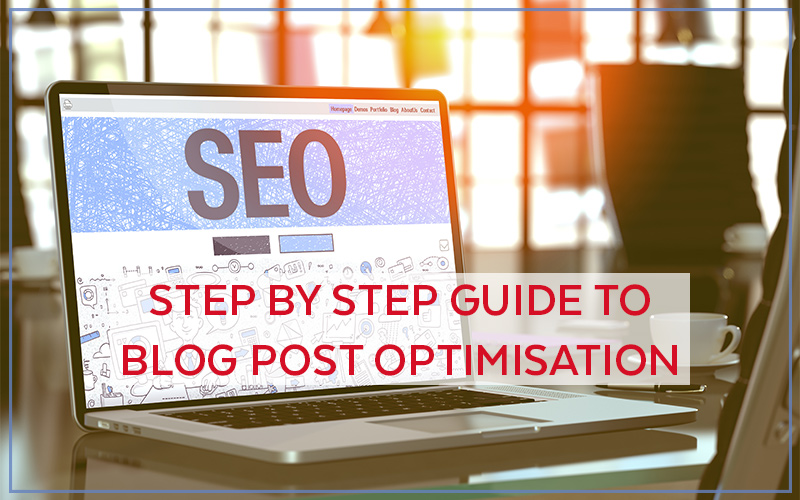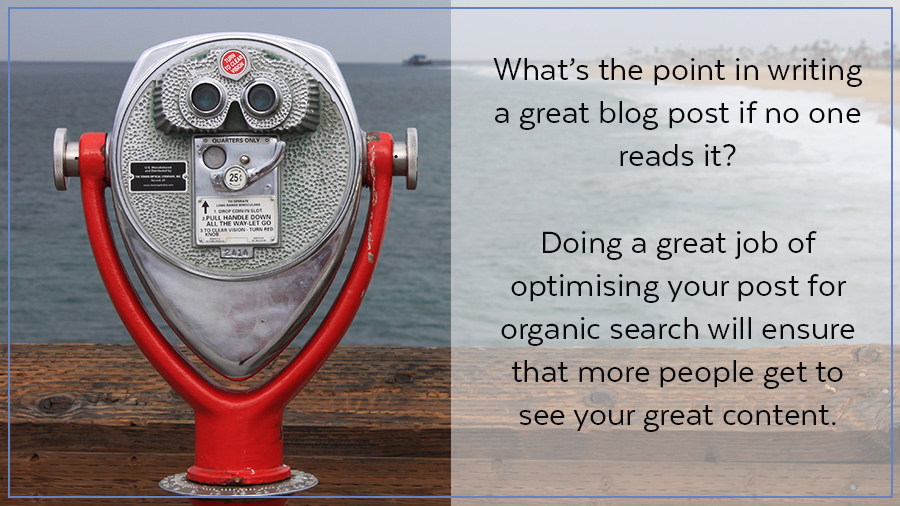Search engine optimisation tips – How to optimise a blog post
The best search engine optimisation involves an ongoing effort of publishing content (blogging for business) and optimising it to be found in organic search results.
We’ve talked a lot about both technical and on page search engine optimisation in general terms but this process is all about developing and maintaining a good standard of SEO practices on your website.
Start by selecting keywords that the page or post will be optimised for based on your research. Keywords should be selected based on:
- how well the post matches user intent,
- approximate search volume and
- ranking difficulty.
If you need some help with keyword research, give us a shout. This is something that we can help with.
With your post written and keyword for optimisation selected you’re ready to optimise your post. To make the process easier for you download a copy of our checklist and use it every time you have a new post to publish.
Don’t let your website get lost in the internet web.
Download your copy of our blog post SEO checklist.
Nail your search engine optimisation everytime.
Spam sucks, you won’t be getting any from us & we’d never share your details.
TITLE
Your post title is one of the first things that search engines will use to understand what your post is about. Clever is great, but always choose a clear title in preference to a clever one. That said, it’s also important to craft titles that people are attracted to and want to click on to read more.
Crafting great titles is a bit of an art form but including the keyword you want to optimise your post for is a great place to start.
Post title should include the keyword near the beginning. We suggest making use of – and : to help place the keyword at the beginning of the title. EG
Keyword: search engine optimisation
Instead of
Title: How to do your own search engine optimisation.
Go with
Title: Search engine optimisation – 5 steps for perfectly optimised blog posts
URL PERMALINK
The permalink is the unique URL where your blog post can be found. The last section of your permalink should include your chosen keyword.
EG
www.mywebsite.com/search-engine-optimisation
If you use relevant categories then a structure like www.mywebsite.com/SEO/search-engine-optimisation would be fine, so would www.mywebsite.com/blog/search-engine-optimisation. Avoid creating too many layers, especially if they aren’t relevant to what the content is about.
Sometimes the default url structure is set to post number www.mywebsite.com/?p=123 or date www.mywebsite.com/2017/03/search-engine-optimisation. For a business blog neither permalink structure is ideal.
If you are going back and optimising previously published blog posts and website pages it’s important to set up a redirect from the old URL to the new one. Redirecting the old URL to the new one ensures that any links to that page or post will still reach the intended destination.
HEADER TAGS
Do you remember learning how to write reports when you were at school?
- Each chapter had a title.
- Each chapter was then divided into a series of sub headings.
- More than one distinct point made under any sub heading would require secondary sub headings.
Think of your header tags in the same way.
- H1 is the top level. For a blog post you would usually only use one (unless you are in the habit of writing several thousand words per blog post in which case you might use two or three).
- H2 come next. Use them for each distinct point in your post
- Then H3, but only if you need them there to break the section down into distinct elements.
- H4, H5 and H6 are there too if you need them…but are of diminishing importance. Like multiple H1 headers it’s unlikely you’ll need these fellas unless you’ve written a really long piece of prose.
Each header tag will have specific formatting. However, they should not be used solely for the purpose of applying formatting. This is poor search engine optimisation practice and will often result in your headers getting out of order.
Think about how you read a piece of text online. Chances are you start by scanning it to get a feel for whether it answers your question. If the text has headers breaking it into sub-sections you’ll get a feel for what’s in there more easily than paragraphs alone.
Search engines seek to understand a piece of internet content in exactly the same way.
A search engine starts by reading the title, then the headers and sub headers and finishes by reading the text in detail.
Properly applied header tags are essential for ensuring that both search engines and people can understand your writing quickly and easily.
TEXT
Think back to everything you learned about writing in high school English. Now forget the parts that aren’t grammar and spelling.
Once upon a time your teacher would tell you that your paragraphs were too short. By modern standards there’s a good chance your paragraphs are now too long.
A high percentage of our day to day reading activity is done on screens. Consequently acceptable writing standards have changed.
Content needs to be easily scannable. Sentences should be short and to the point. Paragraphs cover one point, two at most.
Search engines like in depth articles better than short, fluffy ones. We’ve had great results with posts in excess of 1000-1200 words and rarely publish anything shorter. 400 words is the absolute minimum that we would recommend to a client for a blog post on their website.
Statistics have shown that longer posts, with greater detail about the subject (+3000 words) are more likely to attract shares and external links than shorter pieces. In turn, this helps drive more traffic and increase the apparent authority of the post meaning that it’s likely to rank higher in organic search results.
KEYWORD FREQUENCY
Once upon a search engine optimisation time, an SEO would have shoved as much search engine optimisation into asearch engine optimisation sentence as search engine optimisation possible.
Keyword stuffing methodology is old hat. In fact, if the keyword frequency is too high the post will be penalised.
Yes, it’s important to use your keyword throughout your text but don’t force it and don’t go uneccessarily overboard.
A few times within each sub heading + ensuring it’s in a few of your headers is ample.
LINKS
It’s considered good practice to use 1-3 links as minimum within a piece of content. The links are to other places, ideally on your own site. The purpose of the link should be to add more depth, weight or context to whatever you have been writing about.
Let’s say you’ve got a ‘writing great blot post titles’ post on your website. Adding a link to it from a post about search engine optimisation would be useful to the reader.
You may also have an instructional video on how to create a content plan. That’s useful information for someone who is writing blog posts for their business too link that up, or embed it in your post.
If you’re adding a link then it’s also important to consider the text that you add the link to. Rather than a generic ‘click here’, ‘learn how to write great blog post titles’ is more descriptive and clearer to both the reader and search engines.
META DESCRIPTION
A meta description is the little piece of text someone sees in search results. You have about 160 characters to entice someone to click on your link rather than the one above or below.
It’s understood that search engines don’t use metadescription for ranking purposes. How well you use the piece of real estate impacts on how many clicks you attract when someone sees your page or post listed in search results. Consequently, it’s worth spending a few minutes creating a concise, interesting metadescription for each page and post published.
IMAGES
Alt Tag
An alt tag is text that concisely describes what the image is. Ideally, the alt tags for images within your post or page should include the keyword that you want to optimise the page for.
File name
It’s best practice is to use a file name containing a relevant keyword when you save your image prior to uploading to your website. The file name may be the same as the Alt tag that you apply to the image.
Image Size
Images should be no bigger than is absolutely necessary. There are three elements that contribute to an image size.
- Pixel dimensions. The dimension should be no larger than 1920px, if being used as a full screen image. For images used within blog posts 800px wide is wide enough for most situations.
- File size and quality. All images should be saved optimised for web useage. A plugin like WPSmush can assist with reducing and optimising file size but it will not reduce the dimensions of the image.
- File type will impact on the final image file size. A .jpg is suitable and recommended for the majority of images. A .png is typically used for logos, this file type is larger than a .jpg equivalent.
Don’t let your website get lost in the internet web.
Download your copy of our blog post SEO checklist.
Nail your search engine optimisation everytime.
Spam sucks, you won’t be getting any from us & we’d never share your details.
After Post Publication
Your search engine optimisation efforts don’t end after you push publish. How much traffic flows through your site is a considerable factor in where your posts will rank. Just because you’ve published something doesn’t mean the post will suddenly appear on the first page of Google for the keywords you’ve optimised for. The next step is sharing your post in places that will attract traffic (eyeballs) to your site.
After publishing a new post you should be sharing it to relevant places on social media. It’s also a good time to schedule more shares at a later date into your content calendar.
A quick email to relevant sections of your database is a great way to spike your traffic quickly. The people in your email database are already warm to you so they’re more likely to click through and read what you’ve had to say than your more casual social media audience.
Once your post has been live for a month it’s time to check out the stats. Things that are of interest include:
- How much of the post people are reading?
- Are they converting to a subscriber or buyer?
- Are they navigating to more pages on your site?
- Is your post ranking for the keywords you’ve chosen?
Monitor these things over time and make tweaks and updates accordingly.
I look forward to hearing your results from post optimisations. If you have any questions, don’t know where to start or would like a hand shoot us and email and book in a time to chat.




Thank you so much for this great advice!
No problem Steven! Glad that you found it helpful. Let us know how your optimised posts fare.